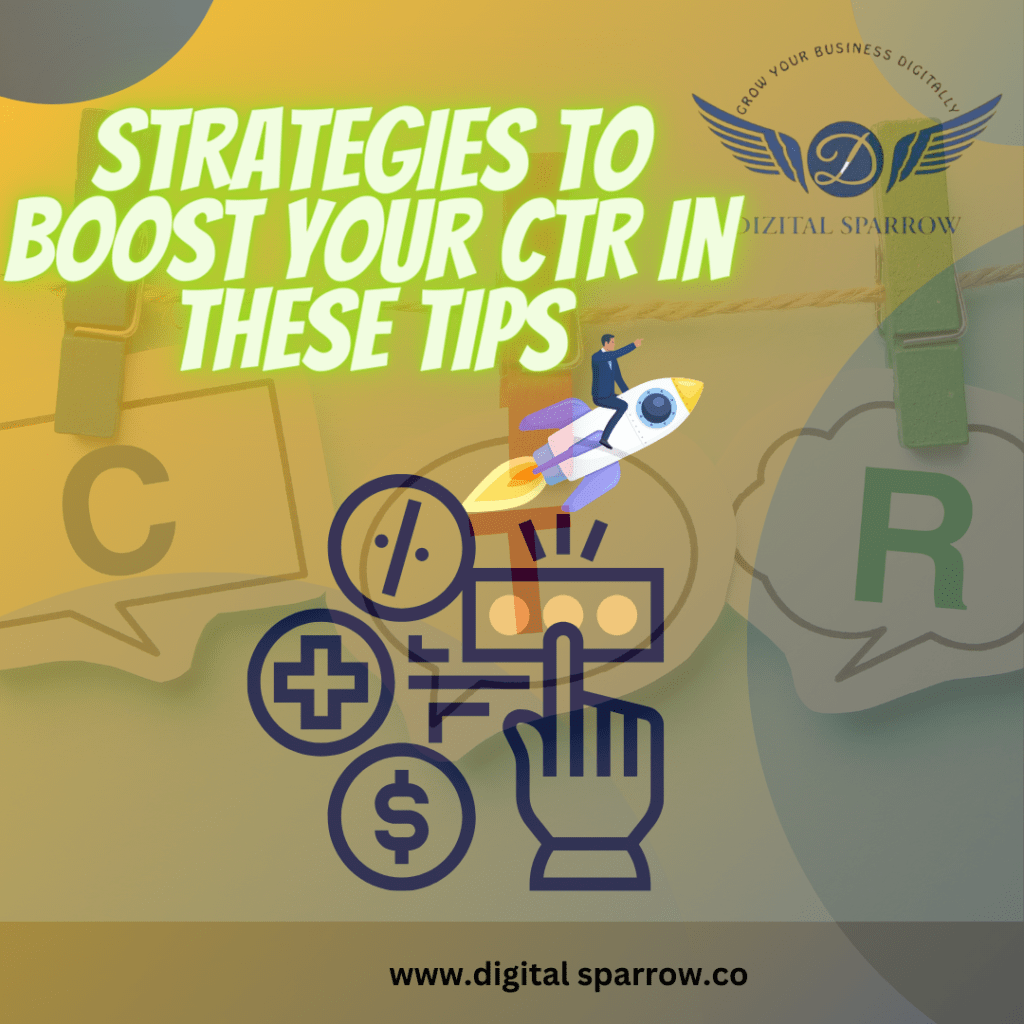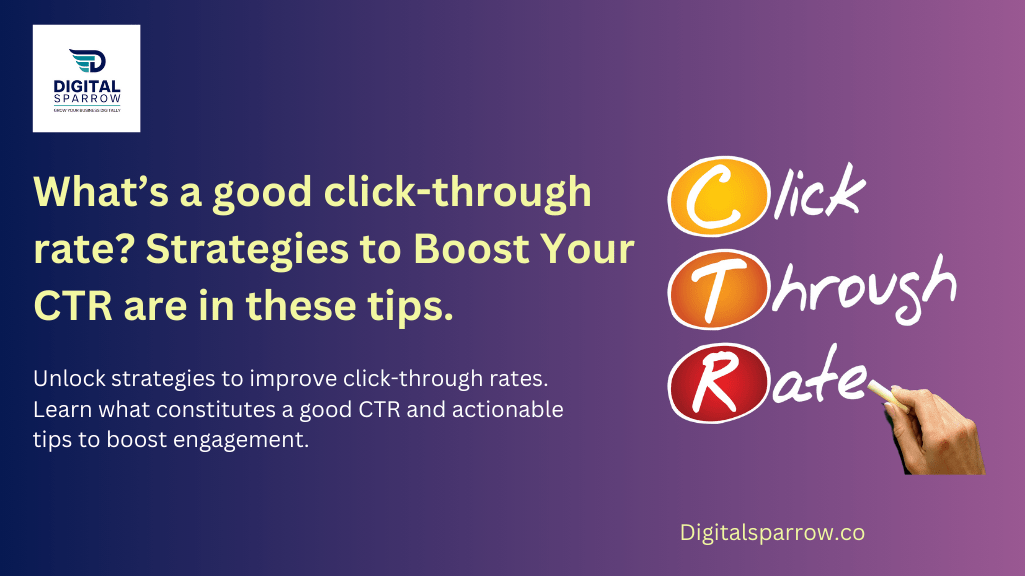The click-through rate (CTR) is a critical metric for digital marketers and website owners. It measures the effectiveness of your online content and can significantly impact your online success. But what’s a good CTR, and how can you boost yours? In this article, we’ll explore the ins and outs of CTR, providing you with actionable tips to enhance your click-through rates and drive more traffic to your website.
What is the click-through Rate (CTR)?
CTR, or Click-Through Rate, is an important indicator in digital marketing and online advertising. It measures the efficiency of an online ad or hyperlink in enticing users to click and proceed to a destination, such as a website or landing page. CTR is computed by dividing the number of clicks on an ad or link by the total number of times it was displayed (impressions) and then expressing the result as a percentage. A higher CTR implies that a greater proportion of users found the material or ad appealing and relevant, making it an important metric of engagement and the effectiveness of an online campaign.
How is CTR Calculated?
The click-through rate (CTR) of a link or ad is computed by dividing the number of clicks by the number of times it was shown (impressions), then multiplying the result by 100 to express it as a percentage. It’s an important indicator in digital marketing because it measures the effectiveness of content and advertisements in engaging the audience.
CTR = (Total clicks on ad/total no of impressions) * 100
For example, If you have 80 clicks and 1000 impressions, your CTR would be 8%.
Factors Affecting CTR
Click-Through Rate (CTR) is influenced by various factors, all of which can impact how successful your digital content or ads are in engaging your audience. Understanding these factors is essential for optimizing your CTR and, consequently, your overall digital marketing success. Here’s a detailed exploration of the key factors affecting CTR:
Relevance of Content
Ad Relevance: Make certain that your ad wording, keywords, and landing sites are closely related to the user’s search intent. Clicks can be discouraged by irrelevant material
Quality of Copy
Compelling Headlines: Craft attention-grabbing headlines that spark curiosity or address a problem.
Clear and Concise Messaging: Communicate your value proposition clearly in ad or content copy.
Strong Call-to-Actions (CTAs): Encourage action with persuasive, actionable language.
Targeting
Audience Targeting: Fine-tune your ads or content to reach the appropriate demographic, regional, or interest-based audience.
Device Targeting: Consider the platform and device your audience is using and optimise your content accordingly.
Ad Placement
Above-the-Fold vs. Below-the-Fold: Ads placed at the top of a webpage tend to receive more attention and clicks.
Ad Format and Design
Visual Appeal: High-quality images and visually appealing designs can increase CTR, especially for display and social media ads.
Ad Size and Format: Choose ad formats that suit the platform and user experience.
Keyword Selection
Relevant Keywords: Choose keywords that correspond to user queries and naturally incorporate them into your content or ad copy.
Load Times and Website Performance
Page Speed: A slow-loading website can deter users from clicking through. Optimize your site for speed.
Mobile Optimization: Ensure that your content is responsive and user-friendly on mobile devices.
https://digitalsparrow.co/business-needs-cro-audit-influences-content/
Competitive Landscape
Ad Position: Higher ad positions on search engine results pages (SERPs) generally result in higher CTR.
Competitor Ads: Analyse your competitors’ strategies and differentiate your content to stand out.
Trust Signals and Social Proof
Testimonials and Reviews: Positive reviews and testimonials can increase trust and CTR.
Trust Badges: Users might feel more secure when they see trust badges, security certificates, and privacy rules.
Ad Scheduling and Timing
Timing: Consider when your target audience is most active online and schedule ads accordingly.
Frequency and Ad Fatigue
Ad Frequency: Showing the same ad too often can lead to ad fatigue, reducing CTR. Rotate ad creatives regularly.
Seasonality and Trends
Seasonal Trends: Adjust your content and ad strategies to capitalize on seasonal or trending topics.
Testing and Optimization
A/B Testing: Test various ad components (headlines, graphics, and CTAs) repeatedly to see which ones resonate the most.
Data Monitoring: To develop data-driven improvements, regularly track and examine CTR statistics.
Relevancy of Landing Page
Ensure that the landing page users are directed to after clicking is relevant, informative, and aligns with their expectations.
Ad Extensions
Ad extensions can be used to include extra details like a location, phone number, or website links, which can improve CTR.
Ad Quality Score (for PPC)
Platforms like Google Ads assign quality scores based on relevance, landing page experience, and expected CTR. Higher-quality scores can result in lower ad costs and better ad placement.

What’s a Good CTR?
Determining what constitutes a “good” Click-Through Rate (CTR) can vary based on factors like industry, platform, and campaign goals. Here are three points to consider in detail:
Industry Benchmarks: A good CTR often aligns with industry benchmarks. Research industry-specific CTR standards to understand what’s typical for your sector. For instance, industries like finance and legal might have CTRs above 2%, while entertainment or healthcare could have lower averages below 1%.
Campaign Goals: A good CTR should be consistent with your campaign objectives. While a lower CTR may be appropriate for efforts that focus on raising awareness, direct response marketing frequently aims for higher CTRs because they signify greater user engagement and conversion intent.
Platform and Ad Type: Expectations for CTR differ depending on the advertising platform and ad type. For instance, search advertisements frequently earn greater CTRs, frequently reaching 1%, while display ads typically have lower CTRs (typically below 0.5%). In order to determine whether your CTR is meeting expectations, evaluate your performance in the context of the particular platform and ad format you’re utilising.
The Difference Between CTR for PPC and Organic Search
click-Through Rate (CTR) in Pay-Per-Click (PPC) advertising and organic search represents distinct user behaviors. The percentage of users who click on your sponsored advertisement after seeing it is measured by CTR in PPC. It’s a clear sign of how effective a campaign is. When it comes to organic search, CTR measures the percentage of people who click on the link to your website in search engine results, providing insight into how effectively your content and meta-data relate to user searches. While both PPC and organic search CTRs strive to generate clicks, PPC CTR depends on the relevance and placement of the ads, while organic search CTR is determined by SEO, the calibre of the content, and how well your website does in search results.
CTR Benchmarks Across Different Industries
Benchmarks for Click-Through Rate (CTR) vary per industry. Due to the difficulty of finding relevant keywords, industries like banking, law, and technology frequently have CTRs above 2%. In contrast, CTRs below 1% may be seen in sectors including entertainment and healthcare, demonstrating a variety of user intents. It’s essential to compare CTR to standards unique to the industry in order to determine success and continuously adjust strategy.
Comparing Your CTR with Industry Averages
Comparing your Click-Through Rate (CTR) to industry averages is critical for determining the effectiveness of your digital marketing activities. It provides insights into how well your campaigns resonate with your target audience and if they outperform or fall short of industry norms. By aligning your CTR with industry benchmarks, you can make informed adjustments to optimise your strategy and maximise engagement and conversion rates.
The Impact of CTR on Other Metrics
The Click-Through Rate (CTR) has a significant impact on various other metrics and aspects of your digital marketing campaigns:
Quality Score (For PPC): In paid advertising, a higher CTR often leads to a better Quality Score. A better Quality Score can result in lower ad costs and improved ad positions.
Conversion Rate: A well-optimized CTR can positively influence the conversion rate. When users are engaged enough to click, they are more likely to take desired actions, such as making a purchase or signing up.
Return on Investment (ROI): CTR affects ROI, as it’s an indicator of how effectively your marketing efforts are at attracting users who are more likely to convert, ultimately impacting revenue and profitability.
Ad Spend Efficiency: Because you’re attracting users who are really interested in your offerings, a higher CTR can lead to a more efficient use of your advertising budget, decreasing wasted ad spend.
Content and Ad Optimisation: Tracking CTR can help you determine whether content or ads are more effective with your target demographic. This knowledge can be used to guide future optimisation efforts and content planning, ultimately enhancing campaign performance.
https://startupadvice.in/why-you-need-a-marketing-plan/
Conclusion
Determining what defines a “good” Click-Through Rate (CTR) is context-dependent and varies by industry, platform, and campaign objectives. While particular numerical targets are vital, focusing on techniques to increase your CTR is equally critical. An excellent CTR is one that corresponds with your goals and beats your previous performance, competitors, or industry averages.
The tactics presented in this article give a detailed road map for increasing your CTR. Crafting compelling headlines, optimising meta descriptions, using high-quality visuals, implementing clear Call-to-Actions (CTAs), conducting A/B testing, ensuring mobile optimisation, monitoring and analysing performance, targeting the right audience, building trust, and adapting to trends are all critical components of CTR enhancement.
Ultimately, what truly matters is the continuous effort to refine your digital marketing tactics, adapt to changing consumer preferences, and optimize your content and ads to resonate with your target audience. A “good” CTR is one that reflects the effectiveness of these strategies in engaging and converting your audience, contributing to your overall digital marketing success.


Pingback: What Is Google Analytics 4 and Should You Use It? - Digital Sparrow
Magnificent goods from you, man. I have understand
your stuff previous to and you are just too magnificent. I
really like what you have acquired here, certainly like what you are stating and the
way in which you say it. You make it entertaining and you still care for to keep it sensible.
I can’t wait to read much more from you. This is actually a terrific website.
I don’t think the title of your article matches the content lol. Just kidding, mainly because I had some doubts after reading the article.